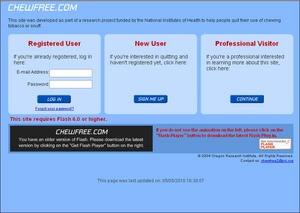ChewFree.com

- Description:
The ChewFree program is largely based on Social Cognitive Theory, in which individuals are viewed as proactive agents who can exercise motivational and self-regulatory skills to change their health habits. The site comprises of a Personal Quitting Assistant (a guided, interactive program to help each user create a tailored plan for quitting and preventing relapse), streaming video (displaying quitting information and testimonials), a range of printable resources, annotated links to other web sites, and two forums (a ‘‘Talk with Others’’ peer forum and an ‘‘Ask an Expert’’ forum to communicate with research project staff). Users set a quit date and the program then provides a schedule to suit the method that individual has chosen, e.g. gradual reduction over a number of weeks, cold turkey or nicotine patches. Users can access a record of their responses and quit plan. Once the quit date is reached, the program provides further support to help with preventing relapse.
- Service URL:
- http://chewfree.com/
- Agency Responsible:
- Oregon Research Institute, funded by the National Cancer Institute.
Details
- Format:
- Website.
- Intervention Type:
- Educational (primarily educational material or psychoeducation). Also utilises social cognitive theory
- Course Length:
- Long (more than 5 modules).
- Support Option:
- Clinical support. Provided through an online forum
Target Audience
- Primary Category:
- Smoking.
- Target Audience:
- Adult.
- Language:
- English.
Access
- Fee:
- Free.
- Access:
- Open: With registration.
- Contact Details:
Research evidence
- Research Trials:
- 1
- Research RCTs:
- 0
- Outcome Summary:
The efficacy of a basic version of the ChewFree website (containing static textual information) was compared to an enhanced version, which included the Personal Quitting Assistant (guided interactive program), streaming video, forums and other resources. Participants in the enhanced condition quit at significantly higher rates than those in the basic condition. Abstinence rates at 3 months were 19.5% for the enhanced condition versus 13.9% for the basic condition and at 6 months were 19.3% versus 14.7%. Data also indicate that participants were well engaged with the program; those using the enhanced site made more visits and spent more time accessing their assigned website than participants assigned to the basic website. The ChewFree enhanced program appears to produce stable decreases in smokeless tobacco use compared to the basic version, however there have been no randomised controlled trials comparing the program to a no-treatment control.
- Recommended rating, reviewer 1:

- Recommended rating, reviewer 2:

Read more about Beacon's Smiley Rating System.
Research paper citations
Efficacy Studies:
- Danaher, B. G., Boles, S. M., Akers, L., Gordon, J. S., & Severson, H. H. (2006). Defining participant exposure measures in web-based health behavior change programs. Journal of Medical Internet Research, 3, e15.
- Severson, H. H., Gordon, J. S., Danaher, B. G., & Akers, L. (2008). ChewFree.com: evaluation of a web-based cessation program for smokeless tobacco users. Nicotine & Tobacco Research, 10(2), 381-391.
Additional references:
- Danaher, B. G., Hart, L. G., McKay, H. G.,& Severson, H. H. (2007). Measuring participant rurality in Web-based interventions. BMC Public Health, 7, 228.
- Danaher, B. G., Smolkowski, K., Seeley, J. R.,& Severson, H. H. (2008). Mediators of a successful web-based smokeless tobacco cessation program. Addiction, 103, 1706-1712.
- Gordon, J. S., Akers, L., Severson, H. H., Danaher, B. G., & Boles, S. M. (2010). Successful participant recruitment strategies for an online smokeless tobacco cessation program. Nicotine & Tobacco Research, Suppl 1, S35-S41.
- Smolkowski, K., Danaher, B. G., Seeley, J. R., Kosty, D. B., & Severson, H. H. (2010). Modeling missing binary outcome data in a successful web-based smokeless tobacco cessation program. Addiction, 105(6), 1005-1015.
User ratings
User ratings and comments are moderated in order to assure the quality of the submissions. It might take a week for your rating to show up.
Your rating
Login to rate this service.
Other user ratings
No ratings for this service yet.
Last Updated: December 15th 2010

 Home
Home
 Categories
Categories Smoking
Smoking